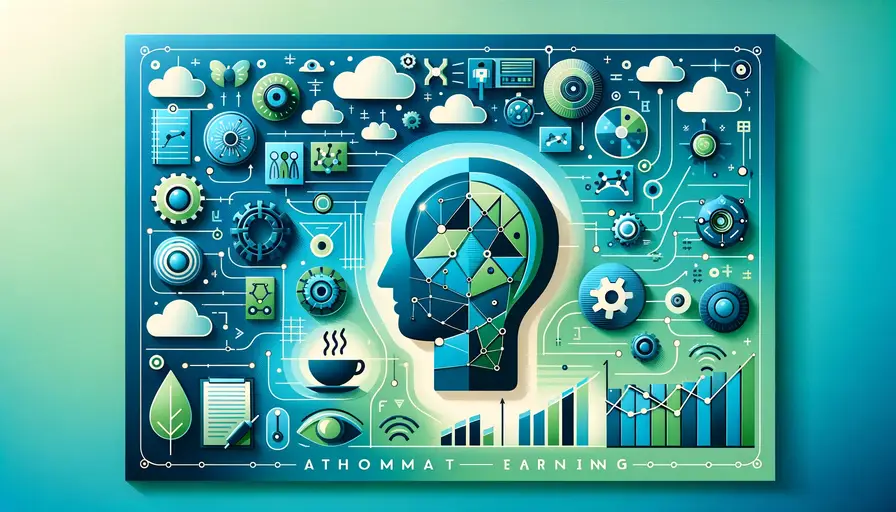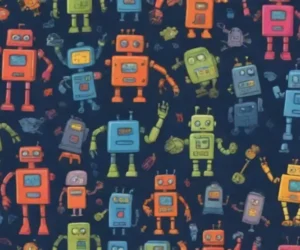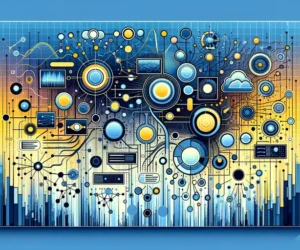
Can Machine Learning Algorithms Truly Teach Themselves?

Self-Learning in Machine Learning
Machine learning algorithms can indeed teach themselves through a process called self-learning. This involves using data to improve their performance over time without needing explicit programming for each task. Self-learning algorithms leverage their ability to process vast amounts of data, identifying patterns and making predictions based on these patterns.
Benefits of Self-Learning Algorithms
The benefits of self-learning algorithms are numerous. First, they can handle large datasets with high dimensionality, extracting meaningful insights that would be difficult for humans to discern. This capability is particularly useful in fields like finance, healthcare, and marketing, where data is abundant and complex.
Another significant advantage is the ability of these algorithms to adapt to new data. Unlike traditional programming, where changes in input data often require rewriting code, self-learning algorithms can update their models based on new information. This adaptability makes them highly valuable in dynamic environments where data patterns continuously evolve.
Additionally, self-learning algorithms can improve over time. As they process more data, they refine their models, leading to more accurate predictions. This iterative improvement process is akin to human learning, where experience leads to better performance.
Rising Demand for AI and Machine Learning Specialists in TechLimitations and Challenges
Despite their advantages, self-learning algorithms face several limitations and challenges. One major challenge is the need for large amounts of high-quality data. Without sufficient data, these algorithms cannot effectively learn and may produce inaccurate results.
Another limitation is the computational resources required. Training complex models, especially deep learning models, can be resource-intensive, necessitating powerful hardware and significant processing time. This can be a barrier for organizations with limited resources.
Moreover, self-learning algorithms can sometimes exhibit unintended biases. If the training data contains biases, the algorithm may learn and propagate these biases, leading to unfair or discriminatory outcomes. Addressing this issue requires careful data preprocessing and ongoing monitoring.
Learning from Data
Machine learning algorithms have the ability to learn from large amounts of data without needing explicit programming for each task. This capability is at the core of their functionality, enabling them to adapt and improve over time.
Machine Learning vs Neural Networks: The Battle for SupremacySupervised Learning
Supervised learning is a common method where algorithms learn from labeled data. In this approach, each training example includes an input and a corresponding correct output. The algorithm uses this data to learn a mapping from inputs to outputs, which it can then apply to new, unseen data.
Here's an example of a supervised learning algorithm using Python:
from sklearn.model_selection import train_test_split
from sklearn.linear_model import LinearRegression
# Assuming X and y are predefined
X_train, X_test, y_train, y_test = train_test_split(X, y, test_size=0.2, random_state=42)
model = LinearRegression()
model.fit(X_train, y_train)
predictions = model.predict(X_test)
print(predictions)Unsupervised Learning
Unsupervised learning involves algorithms discovering patterns in unlabeled data. The goal is to identify hidden structures or relationships within the data. Common techniques include clustering and dimensionality reduction.
For example, clustering algorithms like K-means group similar data points together, which can be useful for market segmentation or anomaly detection. Dimensionality reduction techniques like PCA (Principal Component Analysis) help in simplifying complex datasets by reducing the number of variables.
What are Large Language ModelsReinforcement Learning
Reinforcement learning is a method where algorithms learn through interaction with their environment. They make decisions, observe the outcomes, and adjust their actions to maximize cumulative rewards. This approach is akin to learning by trial and error.
Reinforcement learning has been successfully applied in areas like robotics, gaming, and autonomous driving. Algorithms learn to perform tasks by receiving feedback from their actions and continuously improving their strategies.
Deep Learning and Feature Extraction
By using techniques like deep learning, machine learning algorithms can automatically extract features and patterns from data. Deep learning models, particularly neural networks, have shown remarkable capabilities in processing complex data types such as images, audio, and text.
Unsupervised Learning in Deep Learning
Unsupervised learning in deep learning allows algorithms to discover patterns without labeled data. For instance, autoencoders are a type of neural network used to learn efficient representations of data. They work by compressing the input data into a lower-dimensional space and then reconstructing it, thereby learning important features.
The Formula for Calculating the F-Score in Machine LearningHere's an example of an autoencoder using Python and TensorFlow:
import tensorflow as tf
from tensorflow.keras.layers import Input, Dense
from tensorflow.keras.models import Model
# Define an autoencoder
input_img = Input(shape=(784,))
encoded = Dense(64, activation='relu')(input_img)
decoded = Dense(784, activation='sigmoid')(encoded)
autoencoder = Model(input_img, decoded)
autoencoder.compile(optimizer='adam', loss='binary_crossentropy')
# Assuming X_train is predefined
autoencoder.fit(X_train, X_train, epochs=50, batch_size=256, shuffle=True)Reinforcement Learning: Trial and Error
Reinforcement learning involves learning through trial and error. Algorithms are designed to make decisions, observe the results, and improve their decision-making process over time. This method is particularly effective in dynamic environments where the optimal strategy is not known in advance.
The Role of Human Intervention
Despite the advancements in self-learning algorithms, human intervention remains crucial. Humans are needed to design the architecture of models, select appropriate algorithms, and preprocess data. Additionally, human oversight is essential to ensure ethical considerations and to correct any biases that the algorithms might learn.
Human expertise is also required to interpret the results produced by machine learning models and to make informed decisions based on these results. This collaboration between human intelligence and machine learning creates a powerful synergy, leveraging the strengths of both.
Supervised Machine Learning Types: Exploring the Different ApproachesReinforcement Learning
Reinforcement learning algorithms can learn through trial and error, continuously improving their performance. This method involves balancing exploration (trying new actions) and exploitation (using known actions that yield high rewards).
Exploration and Exploitation Balance
The balance between exploration and exploitation is crucial in reinforcement learning. Too much exploration can lead to inefficiency, while too much exploitation can prevent the discovery of better strategies. Algorithms like epsilon-greedy and upper confidence bound (UCB) help in maintaining this balance.
Here's an example of implementing an epsilon-greedy strategy in Python:
import numpy as np
def epsilon_greedy(Q, state, epsilon):
if np.random.rand() < epsilon:
return np.random.choice(len(Q[state]))
else:
return np.argmax(Q[state])
# Assuming Q is the Q-table and state is the current state
action = epsilon_greedy(Q, state, 0.1)
print(action)Applications of Reinforcement Learning
Reinforcement learning has numerous applications across various fields. In gaming, it has been used to develop agents that can play complex games like Go and chess at superhuman levels. In robotics, it helps in developing autonomous systems that can navigate and perform tasks in dynamic environments.
Are Neural Networks a Type of Machine Learning?In finance, reinforcement learning algorithms are employed to optimize trading strategies by continuously learning from market data. These applications demonstrate the versatility and power of reinforcement learning in solving complex, real-world problems.
Transfer Learning
Transfer learning allows machine learning algorithms to leverage knowledge from previous tasks to learn new tasks. This approach is particularly useful when data for the new task is limited.
How Transfer Learning Works
Transfer learning works by transferring knowledge from a pretrained model to a new model. For instance, a model trained on a large image dataset can be fine-tuned for a specific image classification task with fewer data. This process significantly reduces training time and improves performance.
Here's an example of transfer learning using a pretrained model in Python and Keras:
from tensorflow.keras.applications import VGG16
from tensorflow.keras.models import Model
from tensorflow.keras.layers import Dense, Flatten
# Load a pretrained VGG16 model
base_model = VGG16(weights='imagenet', include_top=False, input_shape=(224, 224, 3))
# Add custom layers for the new task
x = Flatten()(base_model.output)
x = Dense(1024, activation='relu')(x)
predictions = Dense(10, activation='softmax')(x)
model = Model(inputs=base_model.input, outputs=predictions)
# Freeze the layers of the base model
for layer in base_model.layers:
layer.trainable = False
# Compile the model
model.compile(optimizer='adam', loss='categorical_crossentropy', metrics=['accuracy'])
# Assuming X_train, y_train are predefined
model.fit(X_train, y_train, epochs=10, batch_size=32)Benefits and Limitations
The benefits of transfer learning include reduced training time and improved performance, especially in scenarios with limited data. It also allows the application of advanced models to a wider range of tasks.
However, there are limitations. Transfer learning requires a pretrained model that is sufficiently similar to the target task. If the source and target tasks are too different, transfer learning may not be effective.
Generative Adversarial Networks (GANs)
Generative Adversarial Networks (GANs) can learn from each other and improve their performance through competition. GANs consist of two neural networks: a generator and a discriminator, which compete in a zero-sum game.
Learning Through Competition
In GANs, the generator creates fake data, and the discriminator tries to distinguish between real and fake data. This competition drives both networks to improve. The generator aims to produce more realistic data, while the discriminator becomes better at detecting fakes.
Here's an example of training a simple GAN using Python and TensorFlow:
import tensorflow as tf
from tensorflow.keras.layers import Dense, LeakyReLU
from tensorflow.keras.models import Sequential
# Define the generator
generator = Sequential([
Dense(128, input_dim=100),
LeakyReLU(alpha=0.01),
Dense(784, activation='tanh')
])
# Define the discriminator
discriminator = Sequential([
Dense(128, input_dim=784),
LeakyReLU(alpha=0.01),
Dense(1, activation='sigmoid')
])
# Compile the discriminator
discriminator.compile(optimizer='adam', loss='binary_crossentropy', metrics=['accuracy'])
# Combine the two into a GAN
discriminator.trainable = False
gan = Sequential([generator, discriminator])
gan.compile(optimizer='adam', loss='binary_crossentropy')
# Assuming X_train is predefined
for epoch in range(10000):
noise = np.random.normal(0, 1, (32, 100))
generated_data = generator.predict(noise)
real_data = X_train[np.random.randint(0, X_train.shape[0], 32)]
d_loss_real = discriminator.train_on_batch(real_data, np.ones((32, 1)))
d_loss_fake = discriminator.train_on_batch(generated_data, np.zeros((32, 1)))
d_loss = 0.5 * np.add(d_loss_real, d_loss_fake)
noise = np.random.normal(0, 1, (32, 100))
g_loss = gan.train_on_batch(noise, np.ones((32, 1)))
if epoch % 1000 == 0:
print(f"{epoch}: [D loss: {d_loss}] [G loss: {g_loss}]")Continuous Model Updating
By continuously updating their models with new data, machine learning algorithms can adapt and improve their performance. This ongoing learning process is crucial for maintaining model accuracy in dynamic environments.
Importance of Continuous Learning
Continuous learning allows models to stay relevant as new data becomes available. This is particularly important in fields like finance and healthcare, where data patterns change rapidly. By regularly updating their models, algorithms can provide more accurate and timely predictions.
Techniques for Continuous Updating
There are several techniques for continuous updating of models. Online learning algorithms update their parameters incrementally as new data arrives, rather than retraining from scratch. Another approach is to use periodic batch updates, where models are retrained at regular intervals with the latest data.
Challenges and Considerations
The main challenges in continuous updating include managing computational resources and ensuring model stability. Regular updates can be resource-intensive, and there is a risk of overfitting if the model is too sensitive to recent data. Careful monitoring and validation are essential to maintain model performance.
By leveraging continuous learning, machine learning models can adapt to new data and remain effective over time, ensuring they provide valuable insights and predictions.
If you want to read more articles similar to Can Machine Learning Algorithms Truly Teach Themselves?, you can visit the Artificial Intelligence category.



You Must Read